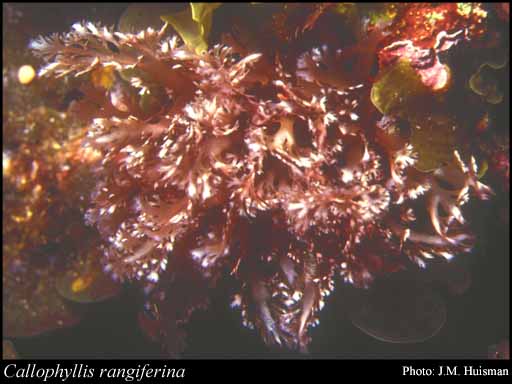- Reference
- Trans.Roy.Soc.South Australia 256 (1973)
- Conservation Code
- Not threatened
- Naturalised Status
- Native to Western Australia
- Name Status
- Current

Scientific Description
Habit and structure. Thallus medium to dark red, 5–20(–25) cm high, with branches essentially in one plane but often displaced, with one to several axes profusely branched in an irregularly lateral to flabellate or subdichotomous manner, usually with much-branched clusters of slender lateral branches in the upper parts; lower axes (2–)3–6 mm broad and in old plants often denuded and marginally proliferous if regrowth occurs, most branches 1–3 mm broad, tapering fairly evenly (or more abruptly in corymbose forms) to slender, lanceolate, usually acute apices less than 0.5 mm broad close to the apex and usually less than 1 mm broad for several millimetres back from the apex; all axes and branches normally sub-branched or with small outgrowths or proliferations at intervals of less than 0.5(–1) cm; substance cartilaginous, slightly to moderately strongly adhering to paper on drying. Holdfast discoid, 2–5 mm across; epilithic. Structure. Thallus usually 200–300 µm thick near apices, 400–500 µm below and 700–800(–1000) µm thick near the base, consisting of a medulla of large, ovoid, and usually thick-walled cells, irregularly arranged and with intermixed small ovoid to elongate cells; cortex of several layers of irregularly ovoid cells, smaller outwards, with the outermost cells in surface view closely packed, isodiametric to ovoid and 3–4 µm across.
Reproduction. Sexual thalli dioecious. Carpogonial branch systems formed in the outer medulla, 60–100 µm across when mature, monocarpogonial with the supporting cell, first cell of the carpogonial branch, and 2–3 subsidiary cells all much lobed and the second cell of the carpogonial branch elongate-ovoid and simple or slightly lobed. Fusion cell 60–90 µm across, producing gonimoblast filaments. Carposporophyte with numerous groups of subspherical to ovoid carposporangia (12–22 µm in diameter) separated by gonimoblast filaments; cystocarps 400–700 µm in diameter, scarcely to moderately swollen and sometimes distinctly protuberant, becoming ostiolate (occasionally with a projecting ostiole in well-developed protuberant cystocarps), situated a few millimetres from the apices. Male thalli with spermatangia cut off from the outer cortical cells, 1.5–2 µm across in surface view, covering young branches and occasionally forming indefinite sori. Tetrasporangia scattered in the outer cortex, cruciately divided, 30–40 µm long by 17–21 µm broad, occasionally aggregated in the form of sori.
Distribution.Recorded from the Chatham I., and New Zealand. Champion Bay, W. Aust., to Tathra, N.S.W and around Tas.
[After Womersley, Mar. Benthic Fl. Southern Australia IIIA: 256–259 (1994)]
Distribution
- IBRA Regions
- Esperance Plains, Geraldton Sandplains.
- IBRA Subregions
- Geraldton Hills, Recherche.
- IMCRA Regions
- Leeuwin-Naturaliste, WA South Coast.
- Local Government Areas (LGAs)
- Cockburn, Esperance, Greater Geraldton, Rockingham.